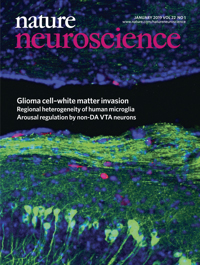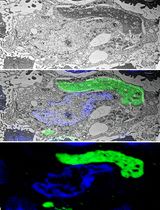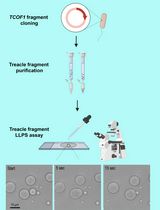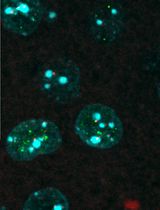- EN - English
- CN - 中文
SarkoSpin: A Technique for Biochemical Isolation and Characterization of Pathological TDP-43 Aggregates
SarkoSpin:一种用于生化分离和鉴定病理性TDP-43聚集体的方法
发布: 2019年11月20日第9卷第22期 DOI: 10.21769/BioProtoc.3424 浏览次数: 6713
评审: Andrew L. Eagledeepika jaiswalEhsan KheradpezhouhAnonymous reviewer(s)
Abstract
TDP-43 is the main aggregating protein in neurodegenerative diseases such as amyotrophic lateral sclerosis (ALS) and frontotemporal lobar degeneration (FTLD). Aggregated TDP-43 is resistant to diverse detergent solubilization, yet physiological TDP-43 and other abundant proteins commonly co-purify with pathological TDP-43. This mixed isolation has precluded the elucidation of the biochemical and structural features of the pathological TDP-43 and its role in disease. Here we describe SarkoSpin, a method for the isolation of pure pathological TDP-43 from patient autopsy brain by sample solubilization with Sarkosyl after nuclease treatment. This purification, which is also applicable to cell culture material, permits the study of biochemical properties of exclusively pathological TDP-43, allowing for the first time the determination of their link to the clinical presentation of FTLD. This method opens up a path for the study of pathological TDP-43 at the molecular and structural level in the heterogeneous spectrum of ALS and FTLD cases.
Keywords: TDP-43 (TDP-43)Background
Protein aggregation in affected neurons is a hallmark of neurodegenerative diseases (Soto et al., 2003). In two of the most devastating forms, amyotrophic lateral sclerosis (ALS) and frontotemporal lobar degeneration (FTLD), the principal aggregating protein is TAR-DNA binding protein 43 (TDP-43) (Ling et al., 2013). Under pathological conditions, TDP-43 is abnormally ubiquitinated, hyperphosphorylated and proteolytically cleaved, and is sequestered in insoluble cytoplasmic inclusions that include both the full-length protein as well as its highly-aggregation prone C-terminal fragment (Neumann et al., 2006; Arai et al., 2006). TDP-43 inclusions account for virtually all ALS patients and for up to 45% of FTLD patients, suggesting that ALS and FTLD are the two ends of a single clinical, genetic and pathological spectrum (Ling et al., 2013). FTLD cases can be subdivided into at least three subtypes (A, B and C) based on the shape and location of the aggregated TDP-43 (Lee et al., 2017), and it was recently shown that different biochemical features of the pathological TDP-43 may underlie this heterogeneity (Laferriere et al., 2019).
An RNA-binding protein (Buratti et al., 2001), TDP-43 forms physiological oligomers that are required to perform its indispensable role in RNA splicing regulation (Afroz et al., 2017). Pathological TDP-43 becomes resistant to solubilization by a wide range of detergents, but its isolation from physiological TDP-43 in brain tissue is hindered by protein-protein and protein-RNA interactions in the lysate. TDP-43 and other RNA-binding proteins containing low complexity domains may form homo- and heterooligomeric species in complex with nucleic acids that become partially insoluble.
Here, we describe SarkoSpin, a purification assay for the isolation of pathological TDP-43 from patient brain tissue by utilizing a single-step solubilization with nuclease treatment (Laferriere et al., 2019). This technique allows for the isolation of pure pathological TDP-43 from 99.8% of the total protein mass, including proteins that form big complexes in their physiological state, such as actin or histones. Isolated TDP-43 is pathologically modified and becomes polyubiquitination, hyperphosphorylated and C-terminally cleaved. Importantly, purified TDP-43 is free from the presence of other RNA-binding proteins containing low-complexity domains, such as hnRNPA1 (heterogeneous nuclear ribonucleoprotein A1), hnRNPH (heterogeneous nuclear ribonucleoprotein H), FUS (fused in sarcoma) or SOD1 (superoxide dismutase 1), which are also associated with ALS and FTLD. The isolation of pure fractions of pathological TDP-43 in combination with other high-resolution techniques will represent a major advancement in the understanding of the molecular mechanisms and structural differences of TDP-43 underlying ALS and FTLD heterogeneity.
Materials and Reagents
- Open-top tubes for an SW60 rotor. e.g., Open-top polyclear tubes 7/16x2-3/8" (Seton, catalog number: 7010)
- Filtered pipet tips (any commercially available are suitable, examples in brackets)
- 10 µl filter tip (STARLAB, catalog number: S1121-3810)
- 20 µl filter tip (STARLAB, catalog number: S1120-1810)
- 200 µl filter tip (STARLAB, catalog number: S1120-8810)
- 1000 µl filter tip (STARLAB, catalog number: S1122-1830)
- 15 ml tubes (any commercially available are suitable, e.g., Greiner Bio-One, catalog number: 188271)
- 50 ml tubes (any commercially available are suitable, e.g., Greiner Bio-One, catalog number: 227261)
- 6-well tissue culture plates (any commercially available are suitable, e.g., TPP catalog number: 92006)
- Protein LoBind tubes 1.5 ml (Eppendorf, catalog number: 0030108116)
- Divisible 250 µl 96-well PCR plates (Eppendorf, catalog number: 0030133374)
- N-Lauroylsarcosine sodium salt (Sarkosyl, Sigma, catalog number: L5125-100G)
- Trizma® hydrochloride (Tris-HCl, Sigma, catalog number: T3253-1KG)
- Sodium chloride (NaCl, Sigma, catalog number: 71380)
- EDTA disodium salt dihydrate (Amresco, catalog number: 0105-1KG)
- DL-Dithiothreitol (DTT, Thermo Scientific, catalog number: R0861)
- Phosphatase inhibitors. e.g., PhosSTOP (Roche, catalog number: 4906837001)
- Complete Mini EDTA-free Protease Inhibitor Cocktail (Roche, catalog number: 11836170001)
- Lysing kit for tissue homogenizing CKMix (Precellys, catalog number: P000918-LYSK0-A)
- Magnesium chloride (MgCl2, Sigma-Aldrich, catalog number: M8266-100G)
- Benzonase nuclease HC, purity > 90% 25KU (Merck, catalog number: 71205-3)
- Cell culture grade phosphate buffered saline (PBS Gibco, catalog number: 10010015)
- Sucrose (Millipore, catalog number: 84100)
- OptiPrepTM Density Gradient Medium (Sigma-Aldrich, catalog number: D1556)
- Dry ice
- Distilled water (Invitrogen, catalog number: 10977035)
- 2x Homogenization-solubilization (HS) buffer (see Recipes)
- 1x HS buffer (see Recipes)
- Benzonase mix (see Recipes)
- 2x HS buffer 4% Sarkosyl (w/v) (see Recipes)
- 1x HS buffer 0.5% Sarkosyl (w/v) (see Recipes)
- Benzonase mix for cell (see Recipes)
- Sucrose cushion (see Recipes)
- 8x HS buffer 4% Sarkosyl (w/v) (see Recipes)
- 2x HS buffer 1% Sarkosyl (w/v) (see Recipes)
Equipment
- Forceps (any commercially available are suitable, e.g., VWR, catalog number 232-1221)
- Scalpel (any commercially available is suitable, e.g., VWR, catalog number 233-5363)
- -80 °C freezer for storage of homogenate aliquots (any commercially available freezer is suitable)
- Minilys homogenizer (P000673-MLYS0-A, Bertin technologies)
- Bucket for dry ice (any commercially available is suitable, e.g., Fisher Scientific, catalog number, 11324085)
- Thermo Mixer C (Eppendorf, catalog number: 5382000015) with SmartBlock 1.5 ml (Eppendorf, catalog number: 5360000038)
- Bench top centrifuge. e.g., PrismTM Microcentrifuge (Labnet International, C2500)
- Gradient Master Base Unit (BioComp, #108) with 7/16" (11 mm) MagnabaseTM holder and marker block for SW60 rotor short caps (BioComp, #105-911A-R)
- Ultracentrifuge. e.g., OPTIMATM XPN-100 ultracentrifuge (Beckman Coulter, A99846)
- SW 60 Ti Swinging-Bucket Rotor (Beckman Coulter, 335649)
- Vortex (any commercially available freezer is suitable; e.g., Scientific Industries, SI-0236)
- Micropipettes (any commercially available are suitable, examples in brackets)
P10 (Eppendorf, catalog number: 3120000020)
P20 (Eppendorf, catalog number: 3120000038)
P200 (Eppendorf, catalog number: 3120000054)
P1000 (Eppendorf, catalog number: 3120000062) - Piston gradient fractionator (BioComp, 152)
- Fraction collector (Gilson, FC203B)
Procedure
文章信息
版权信息
© 2019 The Authors; exclusive licensee Bio-protocol LLC.
如何引用
Pérez-Berlanga, M., Laferrière, F. and Polymenidou, M. (2019). SarkoSpin: A Technique for Biochemical Isolation and Characterization of Pathological TDP-43 Aggregates. Bio-protocol 9(22): e3424. DOI: 10.21769/BioProtoc.3424.
分类
神经科学 > 神经系统疾病 > 神经退行性病变
生物化学 > 蛋白质 > 分离和纯化
分子生物学 > 蛋白质 > 检测
您对这篇实验方法有问题吗?
在此处发布您的问题,我们将邀请本文作者来回答。同时,我们会将您的问题发布到Bio-protocol Exchange,以便寻求社区成员的帮助。
Share
Bluesky
X
Copy link














